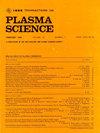Parameter Optimization for Multistage Reluctance Coil Launcher With Residual Energy Recovery and Utilization Mode
IF 1.3
4区 物理与天体物理
Q3 PHYSICS, FLUIDS & PLASMAS
引用次数: 0
Abstract
Launch efficiency is an important indicator to judge the performance of electromagnetic launchers. The goal of the conventional parameter optimization method for multistage launch is to maximize projectile kinetic energy in each stage acceleration. For reluctance coil launchers with residual recovery and utilization mode, the effect of the launcher parameters on the recovery energy should be considered in addition to the kinetic energy of the projectile. In this article, the feasibility of the model and the correctness of the original model are first verified by a four-stage launching experiment. Then, the influence of the drive coil parameters on the projectile acceleration and energy recovery is analyzed through theoretical analysis. In addition, a drive coil parameter optimization method for multistage reluctance coil launchers with residual energy recovery and utilization mode is proposed. By this method, the coil parameters of the original simulation model are optimized, and the simulation and experimental results before and after optimization are compared. The comparison results show that the optimization method proposed in this article integrates the relationship between projectile velocity and recovery energy, which can significantly improve the overall launch efficiency of the multistage system.多级磁阻线圈发射装置剩余能量回收利用模式参数优化
发射效率是衡量电磁发射装置性能的重要指标。传统的多级发射参数优化方法的目标是使每一级加速度下的弹丸动能最大化。对于残余回收利用方式的磁阻线圈发射器,除考虑弹丸的动能外,还应考虑发射器参数对回收能量的影响。本文首先通过四段发射实验验证了模型的可行性和原模型的正确性。然后,通过理论分析,分析了驱动线圈参数对弹丸加速度和能量回收的影响。此外,提出了一种多级磁阻线圈发射装置剩余能量回收利用方式的驱动线圈参数优化方法。通过该方法对原仿真模型的线圈参数进行了优化,并对优化前后的仿真和实验结果进行了比较。对比结果表明,本文提出的优化方法整合了弹丸速度与回收能量之间的关系,能够显著提高多级系统的整体发射效率。
本文章由计算机程序翻译,如有差异,请以英文原文为准。
求助全文
约1分钟内获得全文
求助全文
来源期刊

IEEE Transactions on Plasma Science
物理-物理:流体与等离子体
CiteScore
3.00
自引率
20.00%
发文量
538
审稿时长
3.8 months
期刊介绍:
The scope covers all aspects of the theory and application of plasma science. It includes the following areas: magnetohydrodynamics; thermionics and plasma diodes; basic plasma phenomena; gaseous electronics; microwave/plasma interaction; electron, ion, and plasma sources; space plasmas; intense electron and ion beams; laser-plasma interactions; plasma diagnostics; plasma chemistry and processing; solid-state plasmas; plasma heating; plasma for controlled fusion research; high energy density plasmas; industrial/commercial applications of plasma physics; plasma waves and instabilities; and high power microwave and submillimeter wave generation.
 求助内容:
求助内容: 应助结果提醒方式:
应助结果提醒方式:


